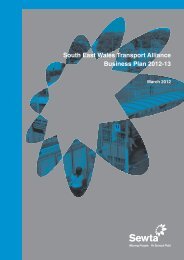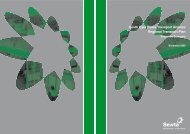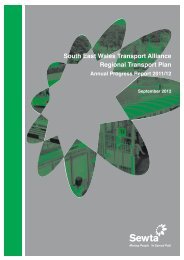Sewta 2013/14 Delivery Plan
Sewta 2013/14 Delivery Plan
Sewta 2013/14 Delivery Plan
Create successful ePaper yourself
Turn your PDF publications into a flip-book with our unique Google optimized e-Paper software.
<strong>Sewta</strong> RTP <strong>Delivery</strong> <strong>Plan</strong> <strong>2013</strong>/<strong>14</strong> – Annex 3a (RTP)RefSchemeRankKey benefits – Outputs (quantified) and outcomesTitle Lead Authority FY<strong>2013</strong>-<strong>14</strong>Scheme Type*MODE / CATEGORY**Total SchemeCost (AllYears)Total RTCG(All Years)Total matchfunding (AllYears)Allocationfrom RTCG13<strong>14</strong>Matchfunding13-<strong>14</strong>TotalSchemecost 13<strong>14</strong>Scheme StartDateScheme EndDate• Bus lanes are created on Rhondda Road and Mill Street. Buses approaching the gyratory from A4058/Broadway will be able to turn right across Sardis Road Bridge to allowquicker and easier access to Catherine Street. Creation of a ‘bus only’ right turn facility will allow easier and quicker access to Catherine Street, enabling buses to avoid havingto circulate around the gyratory system, with a consequential reduction in journey time.• All traffic leaving Catherine Street (such as buses travelling between the bus station and the Rhondda) will be able to turn right and access Mill Street. Consequently, all rightturning traffic from Catherine Street to Mill Street /Rhondda Road will also avoid having to circulate around the gyratory system, being able to turn right and access Mill Street.• Extending the length of the two lane Rhondda Road northbound carriageway by approximately 100m.• Reversing the flow on Mill Street with a bus lane provided on the nearside lane. This will enable northbound traffic exiting Sardis Gyratory to stack on two exit arms, if required.A new signal controlled junction will be created adjacent to the school enabling northbound traffic to egress under signal control.• Additional lengths of bus lane have been provided in the inbound and outbound routes to provide additional benefit, particularly at peak times.Bus Stop InfrastructureThis includes the provision of new bus boarders (raised kerbs), new shelters, new bus stop signs including timetable information, resurfacing the area immediately adjacent to the busstop and where necessary new informal crossing points. This will build upon similar facilities already installed in Taff’s Well, Nantgarw and Trefforest Industrial Estate and extend it fromthere to Pontypridd.Caedelyn Road to Tyn-y-Parc RoadThe scheme will provide an inbound nearside 3m wide bus lane along the A470 between Caedelyn Road and Tyn-y-Parc Road, which is an arterial route into the city centre, which willbenefit both local bus services and regional bus services.Parkfield PlaceCompletion of the nearside, inbound bus lane between the Gabalfa interchange and Parkfield Place.Upper Boat JunctionTraffic flows on the A470 are high at all times and whilst the Pontypridd to Cardiff bus service, number 132, follows the parallel route through Rhydyfelin, Hawthorn, Nantgarw, Taff’sWell, Tongwynlais and Whitchurch, it experiences congestion problems of its own at numerous locations along the way. In particular, Stagecoach has confirmed that improving the flowbetween Main Avenue and Cardiff Road would have a major benefit for buses. It was also a necessary improvement if the two buses as hour in each direction (four in the peak) thatoperate services to Church Village were to be encouraged to operate via the Trefforest Trading Estate instead of via A470 between Upper Boat and Nantgarw. Other services, such as18, 102, 104, 120, 202 and 400E also encounter these problems as they pass through this congested location.The Upper Boat junction currently functions at or very near capacity, while business, residential and educational development continues within the area. At the Upper Boat roundabout,buses experience delays of up to twenty minutes.The Upper Boat junction also serves as a link to the Church Village area and Bypass, the Trefforest and Gelihirion Industrial Estates, a major superstore, retail parks and variousresidential areas, all of which are expanding rapidly, putting pressure on all arms of the junction at all times of the day.The Upper Boat junction improvement will build upon the Nantgarw junction enhancement and encourage improved public transport links to the college, employment, entertainment andretail facilities within Parc Nantgarw and the Trefforest Trading Estate, encouraging more people to use public transport, delivering more sustainable access to jobs and services.The delays experienced by buses at both the Nantgarw and Upper Boat roundabouts are cited by Edwards Coaches as the reason for their Cardiff buses not serving the TrefforestEstate. The improvements would encourage a change of direction by Edwards and increase the number of buses that benefit from the proposals by a further four per hour (eight perhour at peak times), though both the completed Nantgarw and planned Upper Boat improvements need to be delivered for the services to benefit in both directions.Sardis GyratoryPontypridd is the confluence of a number of strategic bus services, with the main bus station being a key hub in the regional transport network. The strategic location of Pontypridd hasplaced significant demands on the existing highway network, with limited opportunities to increase capacity due to a number of physical constraints. This results in significantcongestion, impinging on the ability to provide reliable and consistent journey times for bus services.Services 60A, 99, 100E, 101, 102, 105, 107, 108, 109, 120, 130, 132, 150, 202, 244, X4, X32 and T4 encounter these problems as they pass through this congested location. Service120 from Caerphilly to the Rhondda Fawr has consistently been failing to meet the targets set by the Traffic CommissionerCongestion on the through route to and from the Rhondda Valleys is prevalent, particularly at the Sardis Road Gyratory. Sardis Gyratory is a critical junction in the circulation of busesthrough Pontypridd, with 77 buses in total utilising the Catherine Street arm every hour; therefore opportunities to assist buses through the gyratory would have a significant effect on alarge number of services and passengers. TRANSYT analyses indicate a 30% decrease in bus journey times from Broadway to Catherine Street.Bus journey time savings have been assessed via a TRANSYT analysis for the Sardis Road Proposals. The time savings for all buses passing through the junction in the peak hour arean increase of 78 seconds in the am peak but a significantly greater saving of 584 seconds in the more congested evening peak. Based upon passenger numbers using the affectedservices there is an increase of 0.6 hours in the morning peak and a saving of 7.7 hours in the evening peak. The corresponding saving over a 12 hour day is 17.5 hours. In monetaryterms, it has been estimated that the time savings would amount to over £18k per annum. A benefit/cost ratio of 1.35 has been calculated for the proposals. This could be consideredto be a relatively low value. However, this has been based solely on journey time benefits to existing bus passenger and does not take into account:-• Journey time savings for car users• Growth in passenger numbers• Impact of improved reliability of buses• Economic benefits to the town centreTherefore, it is believed that the actual benefits achieved, when all users are considered, will lead to a substantially better BCR than that quoted.Bus stop improvementsTo enable less able and infirm passengers to board and leave buses more easily and to provide all passengers and possible future passengers with a more comfortable waitingenvironment, with up to date information on services using each individual stop. In relevant cases safe access to the stops will be provided by means of new crossing points in thevicinity. This will encourage more people to use buses.- 6 -






